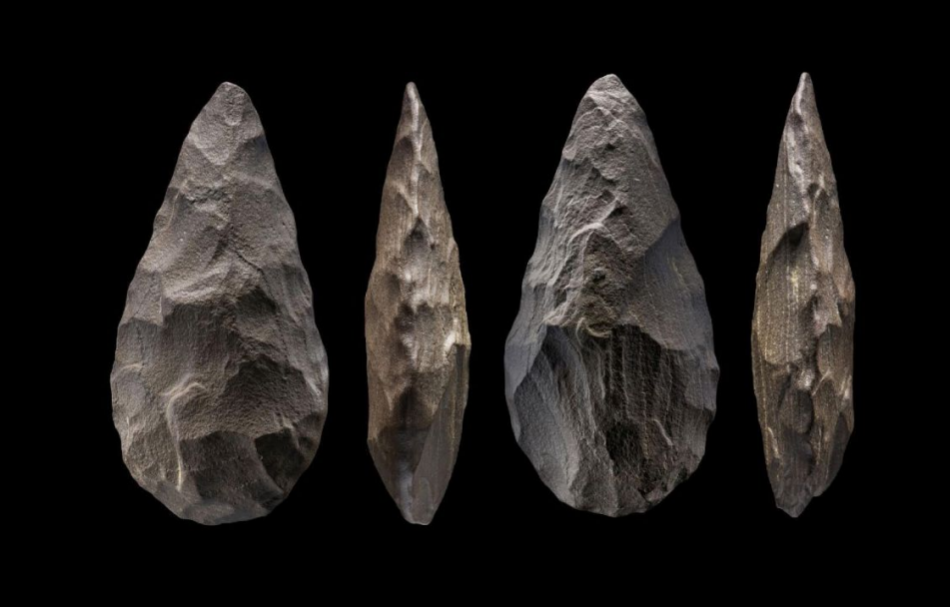sites discovered in Saudi Arabia that are 350 thousand years old

The results of the first Acholi site dated in the Kingdom, "Al-Naseem", appeared in the Nafud desert in the region of Hail, "north of the kingdom". Environmental evidence of the existence of a deep lake that may have been fresh water, with evidence of ancient environmental features and associated archaeological materials dating back to the Middle Pleistocene era. The Naseem site is currently the oldest documented Acholi site so far in the Kingdom, and the curtain reveals at the regional level the types of stone tools used by man in the Middle Pleistocene Age, and it is likely that it indicates the recurrence of man’s return to the Arabian Peninsula when it was meadows and rivers, as the site contains A deep basin in the middle of which there are sediments in which archaeological materials from the Lower Stone Age were found. About 354 stone axes and various stone chips were collected. The survey revealed that there is a strong correlation between the archaeological materials and the dry lake.
The Acholi stone tools at the Naseem site showed that they date back to the late Middle Pleistocene period, within (350,000 to 250,000 years), which is probably consistent with the ninth marine isotope phase when the ice melted in it and formed lakes in the Nafud desert.
And within an article published recently in the international journal Nature Scientific Reports entitled (The spread of man in the Acholi era in the Nafud desert in the north of the Kingdom), the recent results of the environmental and archaeological survey projects that began 10 years ago confirmed that the Arabian Peninsula underwent climatic changes during the Pleistocene era, and its atmosphere became more humid. And the effect of this on the spread of mankind in it and on other continents, and this applies to the human groups in the Acholi period, who were apparently more closely related to water resources than others in the Middle Stone Age.
The article referred to the similarity of the stone tools discovered with those previously found in the Acholi sites in the Nafud desert, and some pieces indicated that raw materials were brought to the site for the manufacture of tools, and some of them were presented after testing their quality, and some pieces were formed before being discarded.
The extensive surveys of the project within the scope of the Nafud desert indicate that local quartzite material was often used to make other stone tools during the Acholi period, which have not yet been dated, including axes of various shapes, including oval, heart, and triangular, in addition to their different sizes, as is the case in other Acholi sites. In the Nafud desert.
The similarity between the Acholi material at the Naseem site and the other undated Acholi sites in the Nafud desert, indicates that the settled deep fresh water in the Nafud desert, such as the Naseem site, contributed to the ease of human spread and movement in return for the fresh water he found and the abundance of fishing around it. The diversity of mammals, large and small, indicates the presence of lakes that were formed during the melting periods of ice in the Nefud region, which indicates the spread of animals in the area during the wet stages and their abundance around water as a source of human livelihood.
The Heritage Authority, with the participation of a group of Saudi experts, is completing the scientific project (Green Arabia) in cooperation with their international counterparts from the Max Planck Institute for the Science of Human History, which focuses on tracking and studying the climatic changes that the Arabian peninsula has undergone throughout the ages, and between the beginning of human settlement. In the country and the migration of people to it through the continents of the ancient world, the results of previous studies of the project revealed evidence of the existence of thousands of lakes, rivers, forests, and creatures throughout the island, around which many successive civilizations arose due to the moderate climate of the Arabian Peninsula at that time.
During the last quarter of the year 2020 AD, the authority announced a very important archaeological discovery that includes the discovery of human footprints, elephants, camels and predatory animals around an ancient, dry lake on the outskirts of the Tabuk region dating back more than 120 thousand years, and this archaeological discovery represents the first scientific evidence The oldest existence of human and animal footprints on the land of the Arabian Peninsula.
The Heritage Authority, through the "Green Arabia Project", seeks to carry out intensive surveys and organized excavations to understand the ancient climatic conditions and the nature of the environment prevailing in the Arabian Peninsula and the subsequent human migrations, as part of the authority's efforts in excavating, preserving, and introducing national antiquities sites within the national strategy. For the culture emanating from the Kingdom's Vision 2030.




